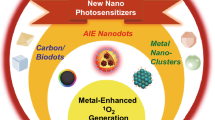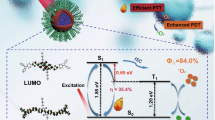Abstract
Photogeneration of singlet oxygen (1O2) by rose bengal is improved through the use of a porous monolithic polymer (PMP) as a support, as compared to a classic gel-type resin matrix. This type of monolithic polymeric matrix can be made at a multigram scale in quantitative yields enabling the preparation of large amounts of supported photosensitizer at low cost. The singlet oxygen induced oxidation of 9,10-diphenylanthracene has been used as a benchmark reaction, and a comparative study using rose bengal in solution, entrapped within gel-type derived polymer and entrapped within a porous monolithic polymer (PMP) has been performed. The enhanced photoreactivity of the PMP-rose bengal conjugates has been utilised for the successful photodynamic therapy (PDT) of melanoma cells.
Similar content being viewed by others
Notes and references
L. Alaerts, J. Wahlen, P. A. Jacobs, D. E. De Vos, Recent progress in the immobilization of catalysts for selective oxidation in the liquid phase Chem. Commun. 2008 1727–1737.
E. L. Clennan and A. Pace, Advances in singlet oxygen chemistry Tetrahedron 2005 61 6665–6691.
M. C. DeRosa and R. J. Crutchley, Photosensitized singlet oxygen and its applications Coord. Chem. Rev. 2002 233 351–371.
Nanomaterials for Cancer Therapy, ed. C. S. S. R. Kumar, Wiley-VCH, Weinheim, 2006.
A. Juzeniene, Q. Peng and J. Moan, Milestones in the development of photodynamic therapy and fluorescence diagnosis Photochem. Photobiol. Sci. 2007 6 1234–1245.
I. J. Macdonald and T. J. Dougherty, Basic principles of photodynamic therapy J. Porph. Phthal. 2001 5 105–129.
E. C. Bloosey, D. C. Neckers, A. L. Thayer and A. P. Schaap, Polymer-based sensitizers for photooxidations J. Am. Chem. Soc. 1973 95 5820–5822.
A. P. Schaap, A. L. Thayer, E. C. Blossey and D. C. Neckers, Polymer-based sensitizers for photooxidations. II J. Am. Chem. Soc. 1975 97 3741–3745.
J. Paczkowski and D. C. Neckers, Polymer-based sensitizers for the formation of singlet oxygen. New studies of polymeric derivatives of rose bengal Macromolecules 1985 18 1245–1253.
J. Paczkowski and D. C. Neckers, Photochemical properties of rose bengal. 11. Fundamental studies in heterogeneous energy transfer Macromolecules 1985 18 2412–2418.
A. P. Schaap, A. L. Thayer, K. A. Zaklika and P. C. Valenti, Photooxygenations in aqueous solution with a hydrophilic polymer-immobilized photosensitizer J. Am. Chem. Soc. 1979 101 4016–4017.
D. C. Neckers, Rose Bengal J. Photochem. Photobiol. A: Chem. 1989 47 1–29.
C. R. Lambert and I. E. Kochevar, Does rose bengal triplet generate superoxide anion? J. Am. Chem. Soc. 1996 118 3297–3298.
M. J. Moreno, E. Monson, R. G. Reddy, A. Rehemtulla, B. D. Ross, M. Philbert, R. J. Schneider and R. Kopelman, Production of singlet oxygen by Ru(dpp(SO3)2)3 incorporated in polyacrylamide PEBBLES Sens. Actuators, B 2003 90 82–89.
W. Tang, H. Xu, R. Kopelman and M. A. Philbert, Photodynamic characterization and in vitro application of methylene blue-containing nanoparticle platforms Photochem. Photobiol. 2005 81 242–249.
D. Gao, H. Xu, M. A. Philbert and R. Kopelman, Ultrafine hydrogel nanoparticles: synthetic approach and therapeutic application in living cells Angew. Chem. Int. Ed. 2007 46 2224–2227.
A. Labib, V. Lenaerts, F. Chouinard, J. C. Leroux, R. Ouellet, J. E. van Lier, Biodegradable nanospheres containing phthalocyanines and naphthalocyanines for targeted photodynamic tumor therapy Pharm. Res. 1991 8 1027–1031.
E. Allemann, J. Rousseau, N. Brasseur, V. S. Kudrevich, K. Lewis, J. E. van Lier, Photodymamic therapy of tumours with hexadecafluoro zinc phthalocyanine formulated in peg-coated poly(lactic acid) nanoparticles Int. J. Cancer 1996 66 821–824.
F. Yan and R. Kopelman, The embedding of meta-tetra(hydroxyphenyl)-chlorin into silica nanoparticle platforms for photodynamic therapy and their singlet oxygen production and pH-dependent optical properties Photochem. Photobiol. 2003 78 587–591.
I. Roy, T. Y. Ohulchanskyy, H. E. Pudavar, E. J. Bergey, A. R. Oseroff, J. Morgan, T. J. Dougherty and P. N. Prasad, Ceramic-based nanoparticles entrapping water-insoluble photosensitizing anticancer drugs: a novel drug-carrier system for photodynamic therapy J. Am. Chem. Soc. 2003 125 7860–7865.
T. Y. Ohulchanskyy, I. Roy, L. N. Goswami, Y. Chen, E. J. Bergey, R. K. Pandey, A. R. Oseroff and P. N. Prasad, Organically modified silica nanoparticles with covalently incorporated photosensitizer for photodynamic therapy of cancer Nano Lett. 2007 7 2835–2842.
S. Kim, T. Y. Ohulchanskyy, H. E. Pudavar, R. K. Pandey and P. N. Prasad, Organically modified silica nanoparticles co-encapsulating photosensitizing drug and aggregation-enhanced two-photon absorbing fluorescent dye aggregates for two-photon photodynamic therapy J. Am. Chem. Soc. 2007 129 2669–2675.
D. C. Hone, P. I. Walker, R. Evans-Gowing, S. Fitz Gerald, A. Beeby, I. Chambrier, M. J. Cook and D. A. Russell, Generation of cytotoxic singlet oxygen via phthalocyanine-stabilized gold nanoparticles: a potential delivery vehicle for photodynamic therapy Langmuir 2002 8 2985–2987.
M. E. Wieder, D. C. Hone, M. J. Cook, M. M. Handsley, J. Gavrilovic and D. A. Russell, Intracellular photodynamic therapy with photosensitizer-nanoparticle conjugates: cancer therapy using a ‘Trojan horse’ Photochem. Photobiol. Sci. 2006 5 727–734.
D. B. Tada, L. L. R. Vono, E. L. Duarte, R. Itri, P. K. Kiyohara, M. S. Baptista, Liane M. Rossi, Methylene blue-containing silica-coated magnetic particles: a potential magnetic carrier for photodynamic therapy Langmuir 2007 23 8194–8199.
L. Shi, B. Hernandez and M. Selke, Singlet oxygen generation from water-soluble quantum dot-organic dye nanocomposites J. Am. Chem. Soc. 2006 128 6278–6279.
A. C. S. Samia, X. Chen and C. Burda, Semiconductor quantum dots for photodynamic therapy J. Am. Chem. Soc. 2003 125 15736–15737.
M. S. Galletero, H. García and J. L. Bourdelande, Dramatic persistence (minutes) of the triplet excited state and efficient singlet oxygen generation for C60 incorporated in Y zeolite and MCM-41 silicate Chem. Phys. Lett. 2003 370 829–833.
S. Wang, R. Gao, F. Zhou and M. Selke, Nanomaterials and singlet oxygen photosensitizers: potential applications in photodynamic therapy J. Mater. Chem. 2004 14 487–493.
J. Wahlen, D. E. De Vos, P. A. Jacobs and P. L. Alsters, Solid materials as sources for synthetically useful singlet oxygen Adv. Synth. Catal. 2004 346 152–164.
F. Svec, J. M. J. Fréchet, New designs of macroporous polymers and supports: from separation to biocatalysis Science 1996 273 205–211.
D. C. Sherrignton, Preparation, structure and morphology of polymer supports Chem. Commun. 1998 2275–2286.
Synthesis and separations using functional polymers, ed. D. C. Sherrington and P. Hodge, John Wiley & Sons Ltd, Chichester, 1988.
Polymeric materials in organic synthesis and catalysis, ed. M. R. Buchmeiser, Wiley-VCH, Weinheim, 2003.
A. Chighine, G. Sechi and M. Bradley, Tools for efficient high-throughput synthesis Drug Disc. Today 2007 12 459–464.
A. Solinas and M. Taddei, Solid-supported reagents and catch-and-release techniques in organic synthesis Synthesis-Stuttgart 2007 2409–2453.
B. M. L. Dioos, I. F. J. Vankelecom and P. A. Jacobs, Aspects of immobilisation of catalysts on polymeric supports Adv. Synth. Catal. 2006 348 1413–1446.
A. Chesney, Selected highlights in the application of ion-exchangers: as supports for reagents in organic synthesis Green Chem. 1999 1 209–219.
F. Svec, J. M. J. Fréchet, Continuous rods of macroporous polymer as high-performance liquid chromatography separation media Anal. Chem. 1992 64 820–822.
C. Vicklund, F. Svec, J. M. J. Fréchet and K. Irgum, Monolithic, “molded”, porous materials with high flow characteristics for separations, catalysis, or solid-phase chemistry: control of porous properties during polymerization Chem. Mater. 1996 8 744–750.
E. C. Peters, F. Svec, J. M. J. Fréchet, Rigid Macroporous Polymer Monoliths Adv. Mater. 1999 11 1169–1181.
M. R. Buchmeiser, Polymeric monolithic materials: syntheses, properties, functionalization and applications Polymer 2007 48 2187–2198.
M. I. Burguete, A. Cornejo, E. García-Verdugo, J. García, M. J. Gil, S. V. Luis, V. Martinez-Merino, J. A. Mayoral and M. Sokolova, Bisoxazoline-functionalised enantioselective monolithic mini-flow-reactors: development of efficient processes from batch to flow conditions Green Chem. 2007 9 1091–1096.
M. I. Burguete, A. Cornejo, E. García-Verdugo, M. J. Gil, S. V. Luis, J. A. Mayoral, V. Martinez-Merino and M. Sokolova, Pybox monolithic miniflow reactors for continuous asymmetric cyclopropanation reaction under conventional and supercritical conditions J. Org. Chem. 2007 72 4344–4350.
N. Karbass, V. Sans, E. García-Verdugo, M. I. Burguete and S. V. Luis, Pd(0) supported onto monolithic polymers containing IL-like moieties. Continuous flow catalysis for the Heck reaction in near-critical EtOH Chem. Commun. 2006 3095–3097.
G. Jas and A. Kirschning, Continuous flow techniques in organic synthesis Chem. Eur. J. 2003 9 5708–5723.
M. I. Burguete, E. García-Verdugo, M. J. Vicent, S. V. Luis, H. Pennemann, N. Graf, von Keyserling and J. Martens, New Supported β-Amino Alcohols as Efficient Catalysts for the Enantioselective Addition of Diethylzinc to Benzaldehyde under Flow Conditions Org. Lett. 2002 4 3947–3950.
B. Altava, M. I. Burguete, J. M. Fraile, J. I. Garcia, S. V. Luis, J. A. Mayoral and S. V. Luis, How important is the inert matrix of supported enantiomeric catalysts? Reversal of topicity with two polystyrene backbones Angew. Chem. Int. Ed. 2000 39 1503–1506.
J. M. Tsay, M. Trzoss, L. Shi, X. Kong, M. Selke, M. E. Jung and S. Weiss, Singlet oxygen production by peptide-coated quantum dot-photosensitizer conjugates J. Am. Chem. Soc. 2007 129 6865–6871.
W. Fudickar and T. Linker, Remote substituent effects on the photooxygenation of 9,10-diarylanthracenes: strong evidence for polar intermediates Chem. Commun. 2008 1771–1773.
B. M. Monroe, Rates of reaction of singlet oxygen with olefins J. Phys. Chem. 1978 82 15–18.
I. E. Kochevar, M. C. Lynch, S. G. Zhuang and C. R. Lambert, Singlet oxygen, but not oxidizing radicals, induces apoptosis in HL-60 cells Photochem. Photobiol. 2000 72 548–553.
G. Hacker, The morphology of apoptosis Cell Tissue Res. 2000 301 5–17.
G. Majno and I. Joris, Apoptosis, oncosis and necrosis. An overview of cell death Am. J. Pathol. 1995 146 3–15.
The reported experimental results were qualitatively reproducible. In order to achieve a quantative assessment of the phototoxicity induced by the new materials, a cell viability assay, such as the MTT assay (9b), should be used.
Author information
Authors and Affiliations
Corresponding authors
Additional information
Electronic supplementary information (ESI) available: Fig S1-S6. See DOI: 10.1039/b810921d
Rights and permissions
About this article
Cite this article
Burguete, M.I., Galindo, F., Gavara, R. et al. Singlet oxygen generation using a porous monolithic polymer supported photosensitizer: potential application to the photodynamic destruction of melanoma cells. Photochem Photobiol Sci 8, 37–44 (2009). https://doi.org/10.1039/b810921d
Received:
Accepted:
Published:
Issue Date:
DOI: https://doi.org/10.1039/b810921d




